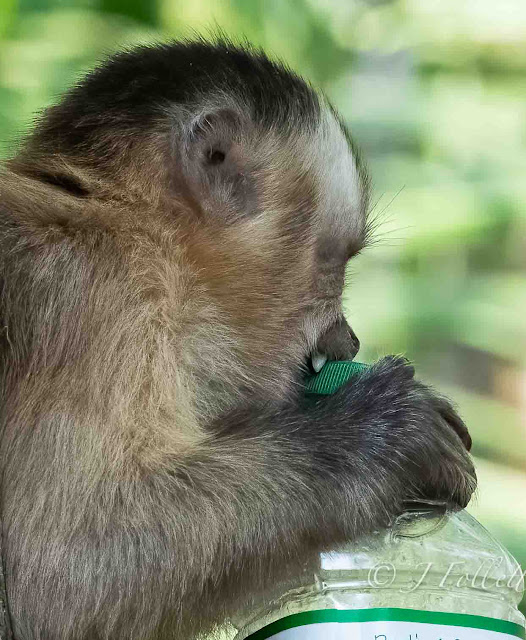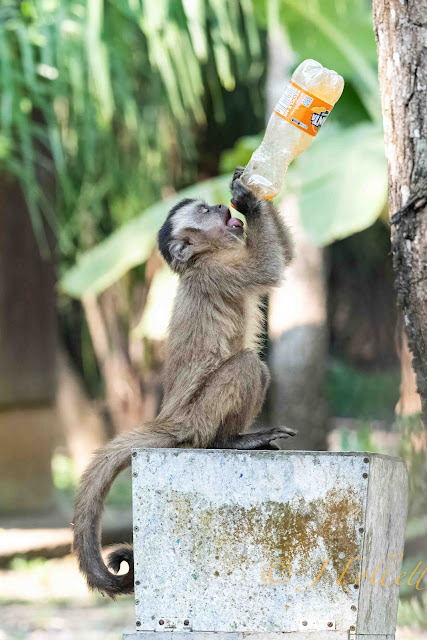(To see photos full screen, click on one and then scroll through them.)
Chapter Eleven
Monkey Business and Monkey Wrenches
When you’re dealing with monkeys,
you’ve got to expect some wrenches.—Alva Bessie
Time is short. We leave tomorrow for our next destination and I haven’t done justice to Hotel Cabanas and the critters that roam its grounds.
Despite the heat, I take my camera and go exploring. I don’t have to go far to find monkeys creating trouble.
They have found a housekeeper’s cart and are raiding it, tearing open the trash bags and escaping with things edible.
One monkey has a Fanta soda bottle and sits atop a container to drink the sweet goodness. Unfortunately for the monkey, the lid is still on the bottle.
 |
| Such hopeful expectations. |
 |
| "Where is it?" |
It doesn’t give up, though, but climbs down, runs across to a tree and when last seen was gnawing on the lid with its teeth.
Other monkeys are in trees with drink bottles, doing much the same, while still others continued scavenging through the cart.
 |
| This one is chewing on the lid of an orange juice bottle. |
 |
| And savoring the "fruits" of his labor. |
We visit Buraco das Araras, the macaw sinkhole, one last time, this time we saw it from the other side.
 |
| Center left you can see the platform where we were twice before? |
 |
| Face on the cliff with a macaw in its eye. It reminds me of the face of the volcano in Disney's short called "I Lava You." |
 |
| Buff-necked ibis with egg in nest |
 |
| Macaw nest on cliff face. |
As we photograph macaws and bird nests in the sinkhole, Octavio hears a familiar sound and leads us to a Toco Toucan, the largest of the toucan species. With its vibrant coloring and huge bill, it is a popular bird.
It is grooming when we see it.
I catch it as it turns its head from its back and I catch it in what I call its Disney pose.
It looks like a blue-eyed sweetie, doesn't it? Though they appear to have blue eyes, this toucan actually has black eyes. The blue is blue skin with a smaller ring of orange skin.
This fellow doesn't stick to fruit with that soft bill. Though they eat a lot of figs when available, they prey on lizards, eggs and nestlings of other birds, including parrots, hyacinth macaws, and buff-necked ibises.
That enormous bill is made up of a hollow bony structure and accounts for as much as half of the toucan's length of 25 inches. These birds can weigh two pounds and can live 20 years.
Also near the toucan was another new bird for me--the blue-throated piping guan.
 |
| Best shot I could get. It soon flew away. |
Described as being "oddly prehistoric" but "handsome", the piping guan is a medium-sized bird at 23 to 25 inches long and weighing up to three pounds. Its favorite fruit is the fig, but it also eats leaves.
They are called "piping" guans after the loud-pitched whistles they make at dawn during mating season.
We have, when time permitted, photographed several animals on the grounds that are new to me.
 |
| Collared peccary |
 |
| Collared peccary |
 |
| Azara's Agouti |
 |
| Azara's Agouti |
Also known as cane rats in Ivory Coast, Africa, Azara's Agouti eat seeds, fruit, and nuts. They're the only animal known that can open a Brazil nut.
Nick-named the "gardener of the forest," agoutis often find more food than they can eat in one day and bury the rest. Sometimes they return for it but other times they forget where it is and the buried matter sprouts new vegetation.
These 20-inch-long rodents are hunted for "bushmeat."
We explored the banks of the rivers that make this a favored playground for humans.
And, not to leave out the birds—though they were a bit of trouble to get a clear shot of in decent light.
 |
| Bare-faced currasow, female |
 |
| Bare-faced currasow, female |
 |
| Bare-faced currasow |
 |
| The crest of a plush-crested jay. |
 |
| Plush-crested jay |
 |
| Red-legged seriema |
 |
| Blue-crowned trogon |
 |
| Blue-crowned trogon |
 |
| Thrush-like wren |
At Rio da Prata, where we ate lunch twice, we found cowboys.
Our last morning. Sitting on the deck by the hotel's restaurant, we spotted a Capuchin monkey with a very young infant on her back. She was checking out the tables by the pool to see what she could raid.
She almost had a slice of watermelon but was scared away at the critical moment and dropped it. Feeding them is frowned upon as they can become quite insistent and possible hurt a guest.
We watch her spy on us though an opening in the rafters.
And now the van is here and we are off on our next adventure—into the Pantanal and the historic Fazenda Barranco Alto Lodge for three nights.
Until, that is, our van is stopped by stern-looking men with assault rifles!!!
***
| erato heliconiam |
 |
| This is a Blue-crowned Motmot, photographed in extremely shady light. Note the extension of the tail. |





















What a great way to begin this Post Gullible! .. Monkey Business and Monkey Wrenches .. When you’re dealing with monkeys, you’ve got to expect some wrenches.—Alva Bessie .. Great beginning Gullible. 45 great photos. Too funny, the monkey with the Fanta bottle still secure trying to get a drink. OMG a monkey going into YOUR bathroom window you could not close from inside. The Toco Toucan in its Disney pose! Great photo. Sweet Capuchin monkey with her baby on her back. Sweet until she raids someones place. Very nice looking river photos. Huh? A Collared peccary and Azara's Agouti. Who'da thunk all these life forms.
ReplyDeleteWhat? Until, that is, our van is stopped by stern-looking men with assault rifles!!! Is this episode going to be covered in an upcoming Post? Smiles .. Cap and Patti
Very next post, Cap. In three or four days.
ReplyDeleteAnother great chapter. Trying to catch up with things.
ReplyDelete